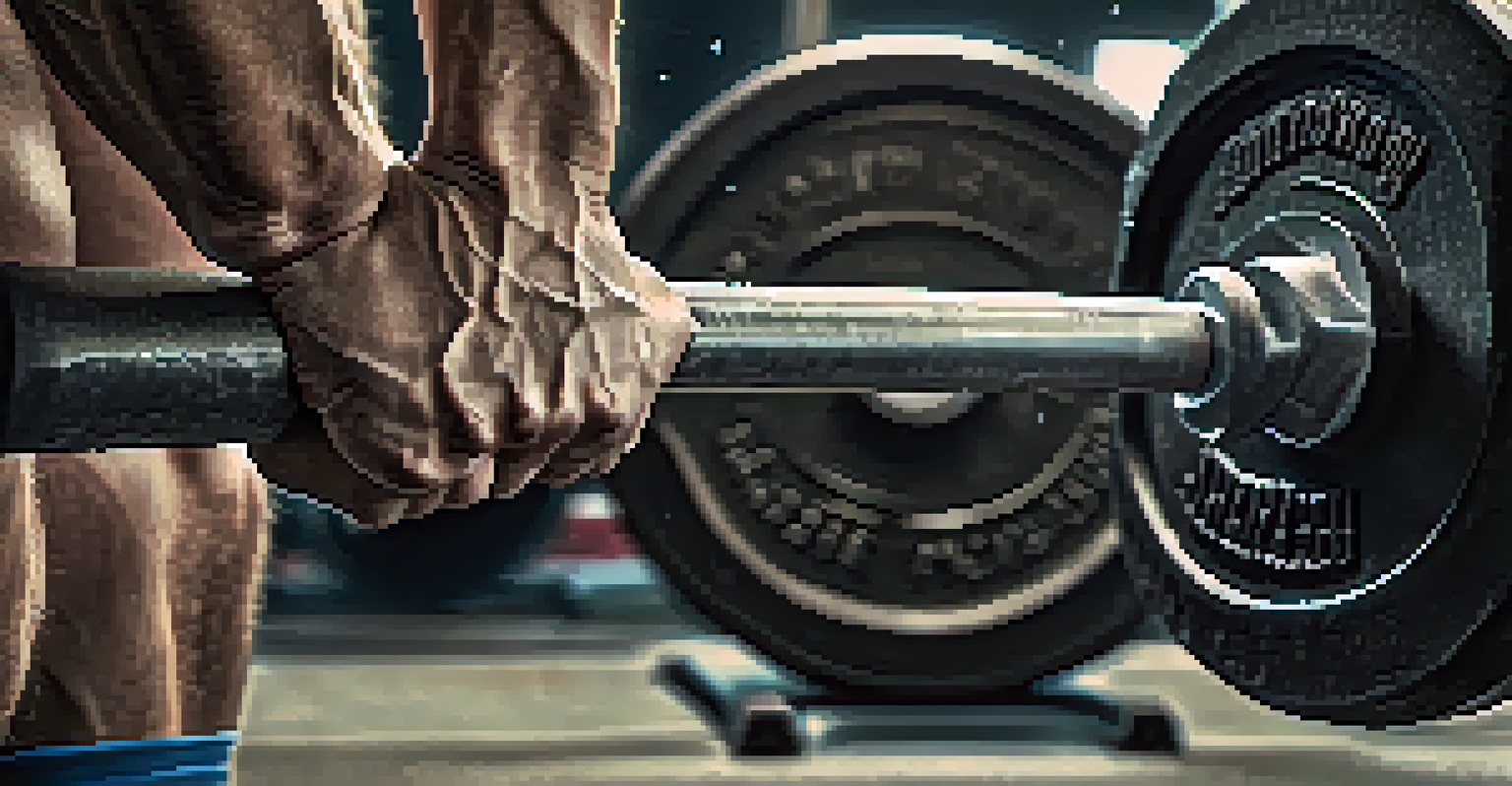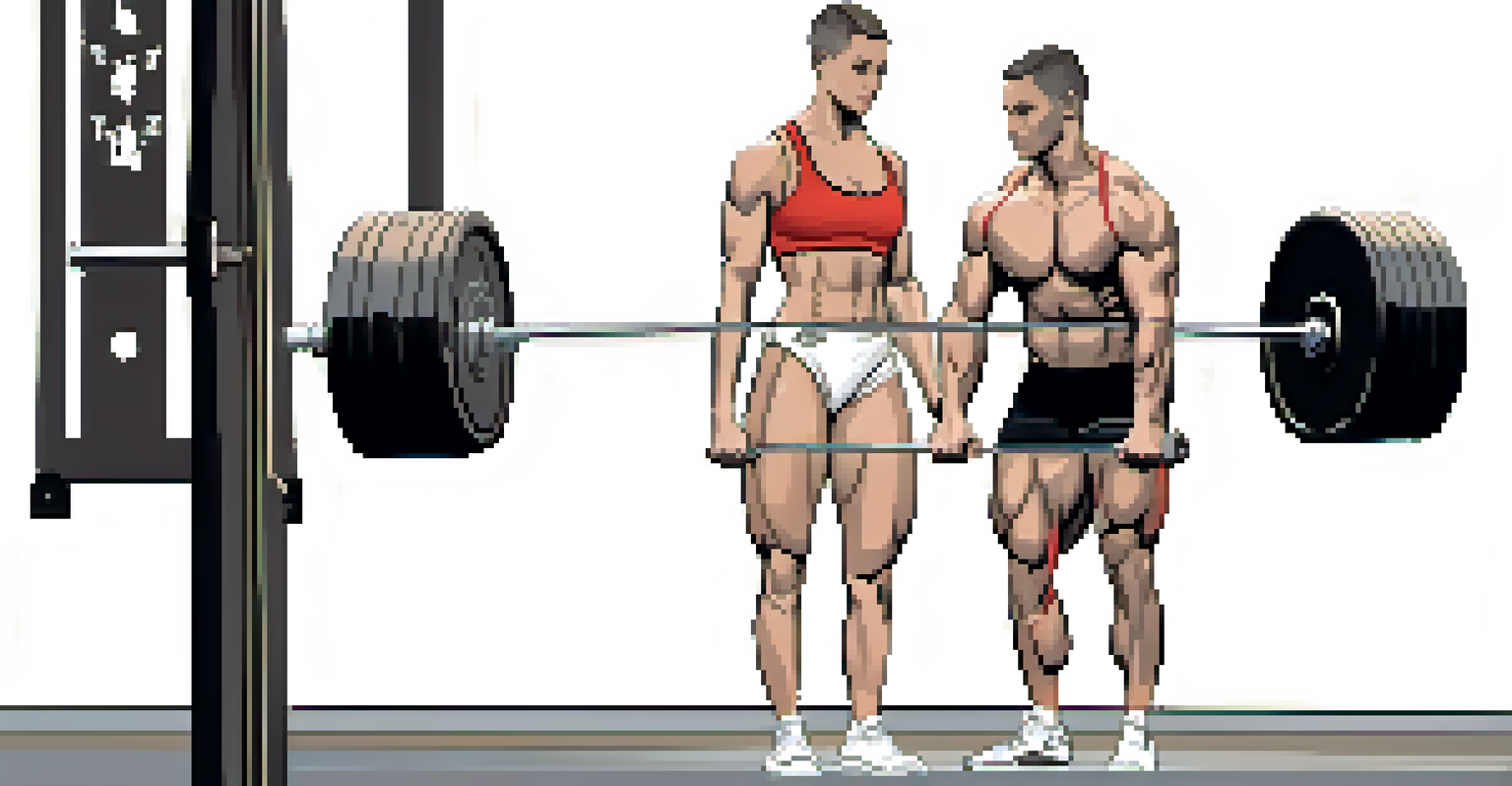Understanding Conventional Deadlift for Powerlifting Success

What is the Conventional Deadlift in Powerlifting?
The conventional deadlift is a staple lift in powerlifting, focusing on lifting a loaded barbell off the ground. It's one of the three main lifts, alongside the squat and bench press, that tests overall strength. This movement primarily targets the posterior chain, which includes muscles like the hamstrings, glutes, and lower back.
Strength does not come from physical capacity. It comes from an indomitable will.
In essence, the conventional deadlift is about bending at the hips and knees to pick up the barbell, making it a functional movement that mimics everyday activities like lifting heavy boxes. Understanding its mechanics is crucial for maximizing your lifting potential. With proper form, lifters can not only improve their performance but also reduce the risk of injury.
Many beginners may feel overwhelmed by the deadlift, but breaking it down into manageable parts can make it easier. Think of it as assembling a puzzle: each piece represents a component of the lift that, when put together, creates a complete picture of strength.
Benefits of the Conventional Deadlift
The conventional deadlift offers a plethora of benefits that extend beyond just building strength. For starters, it enhances overall muscle development, targeting multiple muscle groups in a single movement. This all-in-one workout means you can save time in the gym while still getting an efficient training session.

Additionally, deadlifting improves grip strength, which is essential for various lifts and everyday tasks. A strong grip can contribute to better performance in other lifts, making it a foundational exercise for powerlifting enthusiasts. It's similar to building a strong base for a house; everything else becomes more stable and secure.
Conventional Deadlift Basics
The conventional deadlift is a key powerlifting movement that targets the posterior chain and mimics everyday lifting activities.
Moreover, the deadlift promotes functional strength that translates into real-life activities, helping you lift heavy items with ease. Whether it’s moving furniture or carrying grocery bags, the strength you gain from deadlifting can make everyday tasks feel like a breeze.
Key Techniques for a Successful Deadlift
Mastering the conventional deadlift requires understanding and applying key techniques. Start by setting your feet shoulder-width apart, with your toes slightly pointed outwards. Your grip on the bar should be just outside your knees, ensuring proper alignment and balance as you lift.
Success is the sum of small efforts, repeated day in and day out.
Next, maintain a neutral spine throughout the movement. This means keeping your back flat, avoiding any rounding or excessive arching. Imagine your spine as a straight line from your head to your tailbone, which helps distribute the weight evenly and reduces the risk of injury.
Finally, focus on engaging your core and driving through your heels as you lift. Picture yourself pushing the ground away rather than just lifting the bar; this mental shift can significantly improve your lifting power. With practice, these techniques can help you achieve greater success in your deadlifting journey.
Common Mistakes to Avoid When Deadlifting
Even experienced lifters can fall victim to common mistakes when performing the conventional deadlift. One of the most prevalent issues is rounding the back, which can lead to serious injuries. Always keep your chest up and shoulders back to maintain a strong, neutral spine position throughout the lift.
Another mistake is not engaging the core properly. A weak core can lead to instability during the lift, compromising your form. Think of your core as a brace that supports your spine, allowing you to lift heavier weights safely and effectively.
Benefits Beyond Strength
This exercise not only builds muscle but also enhances grip strength and promotes functional strength for daily tasks.
Lastly, many lifters fail to keep the bar close to their body. When the bar drifts away, it places unnecessary strain on the back. Visualize the bar as a part of your body, almost like a third arm, and keep it as close as possible to maintain optimal leverage and power.
The Importance of Warm-Up and Mobility Work
Before diving into heavy deadlifts, warming up and incorporating mobility work is essential. This preparation helps increase blood flow to the muscles and enhances flexibility, reducing the risk of injury. Think of it as getting your engine running before a long drive; without it, you might stall out.
Dynamic stretches and mobility exercises targeting the hips, hamstrings, and lower back can be incredibly beneficial. Simple movements like leg swings or hip circles can help loosen up tight muscles and prepare your body for the demands of the lift. This step is often overlooked but can make a significant difference in your performance.
Never underestimate the power of a good warm-up; it sets the tone for your entire workout. By taking the time to properly prepare, you'll not only lift more effectively but also recover more quickly afterward.
How to Progress Your Deadlift Over Time
Progressing your deadlift requires a thoughtful approach, focusing on gradual increases in weight and volume. Start by following a structured program that includes variations of the deadlift, such as deficit or sumo deadlifts. These variations help target different muscle groups and break through plateaus.
Incorporate incremental weight increases into your training routine. This could be as little as 2.5 to 5 pounds at a time, allowing your body to adapt without risking injury. Consistency is key; think of it as nurturing a plant: with regular care and attention, it will grow stronger over time.
Key Techniques for Success
Maintaining proper form, engaging your core, and keeping the bar close are essential techniques for a successful deadlift.
Lastly, track your progress and celebrate small victories along the way. Keeping a training log can provide motivation and insight into what works best for you. By recognizing your achievements, no matter how small, you'll stay engaged and excited about your deadlifting journey.
Incorporating the Deadlift into Your Training Program
To reap the full benefits of the conventional deadlift, it's essential to incorporate it wisely into your training program. Consider scheduling deadlift sessions once or twice a week, allowing adequate recovery time between workouts. This frequency helps build strength while preventing burnout.
Pair the deadlift with complementary exercises that target the posterior chain, such as Romanian deadlifts or good mornings. This pairing can enhance your overall strength and performance in the conventional deadlift. Think of it as building a solid foundation; the stronger your base, the higher you can reach.

Finally, listen to your body and adjust your training accordingly. If you're feeling fatigued or experiencing discomfort, it may be time to scale back. Remember, progress isn’t always linear, and maintaining a balanced approach will help you achieve long-term success in powerlifting.